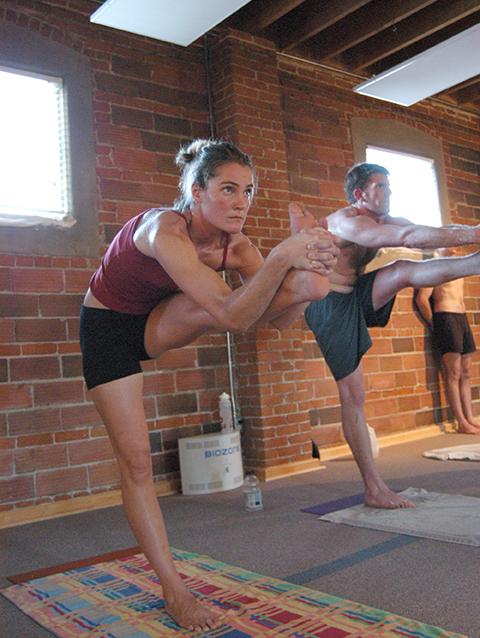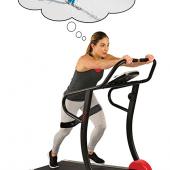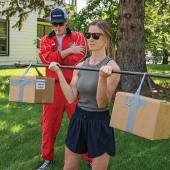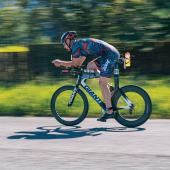Blessed Are the Yogis
Stretching for optimal ski fitness.
What do yoga and skiing have in common? The need for balance, flexibility, and focus.
Yoga helps cultivate these qualities, so it follows that practicing yoga can help improve ski technique. Let's face it—we love skiing for its adrenaline rush. But the other side of this coin is the potential for injury, and yoga can help prevent damage by addressing your body’s imbalances and fostering both strength and flexibility. Yoga also encourages a focus on breathing, which is the starting point for managing fear or a tense physical body. By being able to concentrate on your breathing, transitioning your movements with grace, and cultivating an awareness of body balance and alignment, any level of skier will get more out of their time on the mountain and be less injury-prone.
Now on to more technical stuff: In both yoga and skiing, core strength is essential. If we have a strong, stable core we will be able to control our movements with more precision. In skiing, a strong core will help take the pressure off the knees, which typically end up bearing too much weight if the glutes, quads, and back muscles are weak. We’ve all seen this happen (and have probably done it once or twice too): a skier jerking her upper body in order to turn, while her lower body remains facing the opposite direction—ouch. This person is disconnected from her center, which along with her knees and hips, should be in the driver’s seat for a turn. In yoga class an often-heard refrain is “draw your navel in toward your spine.” This helps cultivate an awareness of our core as the body’s center and source of stability. A skier needs to get her core under control in order to be stable and direct other body parts’ movements with precision, whether carving smooth S-turns on a groomer or reacting quickly to unexpected terrain.
Lastly, If you’re a sporadic skier or tend to hit the mountain with cold muscles, you’re basically asking for it. Bridge the gap between ski sessions with some yoga moves to keep your muscles limber, and you can use the same poses to stretch out before and après-ski.
Here are some of my top yoga pose picks for the ski season:
Yoga Push-Ups
Skiing is lower-body intensive, so in the true spirit of yoga, we need to balance that with some upper-body work.
• Start in downward facing dog with your hips up, neck relaxed, with your ears between your arms.
• As you inhale, come forward into plank pose (push-up position). Don’t let your hips drop; keep your body in one straight line as you lower down to hover above the floor.
• Here’s the tough part: Inhale, straighten the arms, and push the floor away to come back up to plank. Do everything you can to keep your body one straight line—pay attention to the position of your hips.
• Exhale as you push the hips up and back into downward facing dog. Keep your neck relaxed and your gazing point between your feet. Hold for three deep breaths.
• Repeat this sequence five to ten times.
Tree Pose
Let your breath be your source of balance; if you hold your breath, you’re more likely to fall (the same applies on the ski slope).
• Stand in mountain pose and gaze softly at a fixed point in front of you on the floor, about four or five feet away.
• Shift your weight to the left foot, keeping the standing foot firmly connected to the floor, and bend your right knee.
• Reach down with your right hand and grab your right ankle.
• Draw your right foot up and place the sole as high up on the inner left thigh as possible; press the right heel into the inner left groin, toes pointing toward the floor.
• Firmly press the right foot sole against the inner thigh and resist with the outer left leg.
• Press your hands together at your heart center. Maintain your gazing point on the floor. If you fall out of the pose at any point, slowly and deliberately go through the process again.
• Stay in the pose for 30 seconds to one minute. Return to mountain pose and repeat for the same length of time on the opposite side.
Hero Pose
This pose keeps the quads and muscles around the knees supple—less strain on the knee joint means less chance of knee injury. It’s important to respect your knees when coming into hero—move slowly and do not push. Use a rolled-up towel or yoga block if you have knee problems or if your quad and knee muscles are especially tight.
• Kneel on the floor with your knees and thighs together. Take the feet a little wider than hip-distance apart. Place the towel or block between your heels.
• Use your thumbs to move your calf muscles out to the sides as you sit down between your heels (remove the towel or block if you don’t need it).
• Your heels should be just outside your hips, with all five toenails on the floor.
• Let the top of your head lift up toward the ceiling to lengthen the spine.
• If this pose is too intense, you need more padding under your butt. Once things open up more, you’ll be able to reduce the padding and eventually sit down between your heels.
• Hold for three to five minutes.
Margaret Burns Vap is a yoga instructor and entrepreneur. She owns Bozeman-based Big Sky Yoga Retreats and a yoga studio in Washington D.C. Contact her at margaret@bigskyyogaretreats or visit bigskyyogaretreats.com.











